Olympus E-410 vs Panasonic L10
The Olympus E-410 and the Panasonic Lumix DMC- L10 are two digital cameras that were revealed to the public, respectively, in March 2007 and August 2007. Both are DSLR (Digital Single Lens Reflex) cameras that are equipped with a Four Thirds sensor. Both cameras offer a resolution of 10 megapixels.
Below is an overview of the main specs of the two cameras as a starting point for the comparison.

Check E-410 offers at
ebay.com

Check L10 offers at
ebay.com
Going beyond this snapshot of core features and characteristics, what are the differences between the Olympus E-410 and the Panasonic Lumix DMC- L10? Which one should you buy? Read on to find out how these two cameras compare with respect to their body size, their imaging sensors, their shooting features, their input-output connections, and their reception by expert reviewers.
Body comparison
The physical size and weight of the Olympus E-410 and the Panasonic L10 are illustrated in the side-by-side display below. The two cameras are presented according to their relative size. Three successive views from the front, the top, and the rear are shown. All width, height and depth measures are rounded to the nearest millimeter.
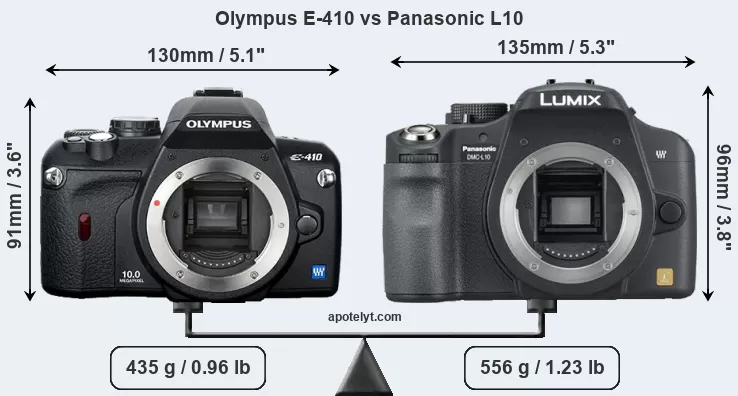
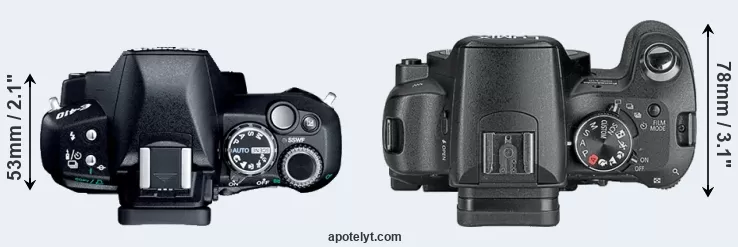
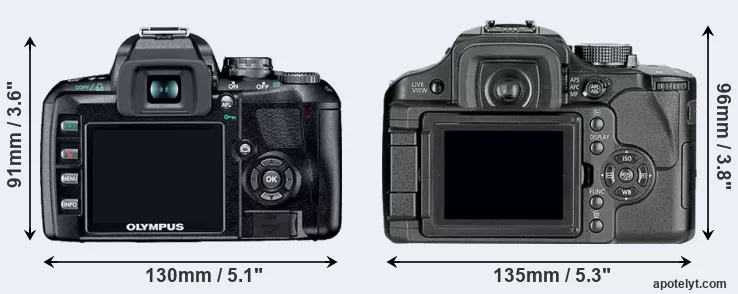
If the front view area (width x height) of the cameras is taken as an aggregate measure of their size, the Panasonic L10 is notably larger (10 percent) than the Olympus E-410. Moreover, the L10 is markedly heavier (28 percent) than the E-410. In this context, it is worth noting that neither the E-410 nor the L10 are weather-sealed.
The above size and weight comparisons are to some extent incomplete since they do not consider the interchangeable lenses that both of these cameras require. In this particular case, both cameras feature the same lens mount, so that they can use the same lenses. You can compare the optics available in the Four Thirds Lens Catalog.
The adjacent table lists the principal physical characteristics of the two cameras alongside a wider set of alternatives. If you would like to visualize and compare a different camera combination, you can navigate to the CAM-parator app and make your selection from a broad list of cameras there.

| Camera Model |
Camera Width |
Camera Height |
Camera Depth |
Camera Weight |
Battery Life |
Weather Sealing |
Camera Launch |
Launch Price |
Street Price |
||
|---|---|---|---|---|---|---|---|---|---|---|---|
| 1. | Olympus E-410 | 130 mm | 91 mm | 53 mm | 435 g | 500 | n | Mar 2007 | US$ 699 | ebay.com | |
| 2. | Panasonic L10 | 135 mm | 96 mm | 78 mm | 556 g | 450 | n | Aug 2007 | US$ 599 | ebay.com | |
| 3. | Canon XSi | 129 mm | 98 mm | 62 mm | 524 g | 500 | n | Jan 2008 | US$ 799 | ebay.com | |
| 4. | Olympus E-400 | 130 mm | 91 mm | 53 mm | 435 g | 500 | n | Sep 2006 | US$ 699 | ebay.com | |
| 5. | Olympus E-420 | 130 mm | 91 mm | 53 mm | 440 g | 500 | n | Mar 2008 | US$ 599 | ebay.com | |
| 6. | Olympus E-450 | 130 mm | 91 mm | 53 mm | 440 g | 500 | n | Mar 2009 | US$ 499 | ebay.com | |
| 7. | Olympus E-510 | 136 mm | 92 mm | 68 mm | 538 g | 750 | n | Mar 2007 | US$ 799 | ebay.com | |
| 8. | Olympus E-520 | 136 mm | 92 mm | 68 mm | 535 g | 750 | n | May 2008 | US$ 699 | ebay.com | |
| 9. | Olympus E-620 | 130 mm | 94 mm | 60 mm | 521 g | 500 | n | Feb 2009 | US$ 699 | ebay.com | |
| 10. | Olympus E-P3 | 122 mm | 69 mm | 34 mm | 369 g | 330 | n | Jun 2011 | US$ 799 | ebay.com | |
| 11. | Panasonic G1 | 124 mm | 84 mm | 45 mm | 360 g | 410 | n | Sep 2008 | US$ 599 | ebay.com | |
| 12. | Panasonic G10 | 124 mm | 84 mm | 74 mm | 388 g | 380 | n | Mar 2010 | US$ 499 | ebay.com | |
| 13. | Panasonic L1 | 146 mm | 87 mm | 64 mm | 606 g | 750 | n | Feb 2006 | US$ 999 | ebay.com | |
| Note: Measurements and pricing do not include easily detachable parts, such as add-on or interchangeable lenses or optional viewfinders. | |||||||||||
The price is, of course, an important factor in any camera decision. The retail prices at the time of the camera’s release place the model in the market relative to other models in the producer’s line-up and the competition. The L10 was launched at a somewhat lower price (by 14 percent) than the E-410, which makes it more attractive for photographers on a tight budget. Normally, street prices remain initially close to the MSRP, but after a couple of months, the first discounts appear. Later in the product cycle and, in particular, when the replacement model is about to appear, further discounting and stock clearance sales often push the camera price considerably down.
Sensor comparison
The imaging sensor is at the core of digital cameras and its size is one of the main determining factors of image quality. A large sensor will tend to have larger individual pixels that provide better low-light sensitivity, wider dynamic range, and richer color-depth than smaller pixel-units in a sensor of the same technological generation. Furthermore, a large sensor camera will give the photographer more possibilities to use shallow depth-of-field in order to isolate a subject from the background. On the downside, larger sensors tend to be more expensive and lead to bigger and heavier cameras and lenses.
Both cameras under consideration feature a Four Thirds sensor and have a format factor (sometimes also referred to as "crop factor") of 2.0. Within the spectrum of camera sensors, this places the review cameras among the medium-sized sensor cameras that aim to strike a balance between image quality and portability. Both cameras feature a native aspect ratio (sensor width to sensor height) of 4:3.
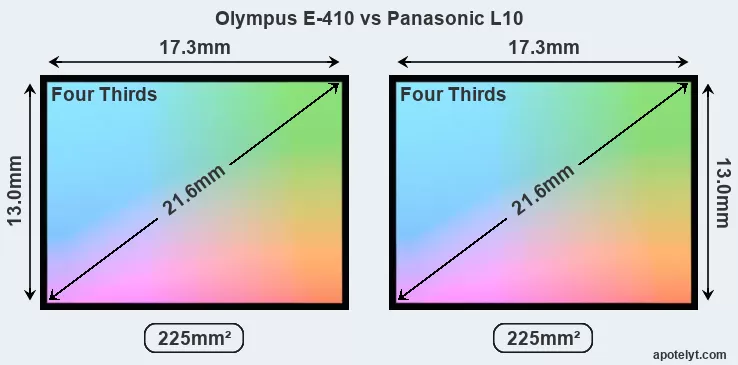
The two cameras under review do not only share the same sensor size, but also offer an identical resolution of 10 megapixels. This similarity in sensor specs implies that both the E-410 and the L10 have the same pixel density, as well as the same pixel size. It should, however, be noted that the L10 is a somewhat more recent model (by 5 months) than the E-410, and its sensor might have benefitted from technological advances during this time.
The Olympus E-410 has a native sensitivity range from ISO 100 to ISO 1600. The Panasonic Lumix DMC- L10 offers exactly the same ISO settings.
Technology-wise, both cameras are equipped with CMOS (Complementary Metal–Oxide–Semiconductor) sensors. Both cameras use a Bayer filter for capturing RGB colors on a square grid of photosensors. This arrangement is found in most digital cameras.
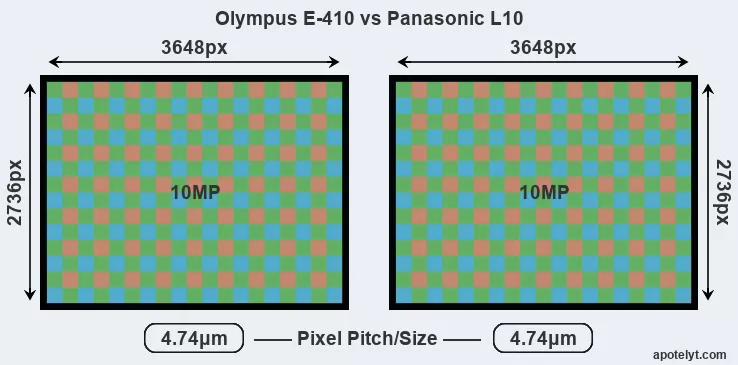
Since 2007, DXO Mark has published sensor performance measurements that have been derived using a consistent methodology. This service assesses and scores the color depth ("DXO Portrait"), dynamic range ("DXO Landscape"), and low-light sensitivity ("DXO Sports") of camera sensors, and also publishes an overall camera score. Of the two cameras under consideration, the L10 has a markedly higher DXO score than the E-410 (overall score 4 points higher), which will translate into better image quality. The advantage is based on 0.2 bits higher color depth, 0.8 EV in additional dynamic range, and 0.2 stops of reduced low light sensitivity. The adjacent table reports on the physical sensor characteristics and the outcomes of the DXO sensor quality tests for a sample of comparator-cameras.

| Camera Model |
Sensor Class |
Resolution (MP) |
Horiz. Pixels |
Vert. Pixels |
Video Format |
DXO Portrait |
DXO Landscape |
DXO Sports |
DXO Overall |
||
|---|---|---|---|---|---|---|---|---|---|---|---|
| 1. | Olympus E-410 | Four Thirds | 10.0 | 3648 | 2736 | none | 21.1 | 10.0 | 494 | 51 | |
| 2. | Panasonic L10 | Four Thirds | 10.0 | 3648 | 2736 | none | 21.3 | 10.8 | 429 | 55 | |
| 3. | Canon XSi | APS-C | 12.2 | 4272 | 2848 | none | 21.9 | 10.8 | 692 | 61 | |
| 4. | Olympus E-400 | Four Thirds | 10.0 | 3648 | 2736 | none | 21.0 | 10.6 | 127 | 53 | |
| 5. | Olympus E-420 | Four Thirds | 10.0 | 3648 | 2736 | none | 21.5 | 10.4 | 527 | 56 | |
| 6. | Olympus E-450 | Four Thirds | 10.0 | 3648 | 2736 | none | 21.5 | 10.5 | 512 | 56 | |
| 7. | Olympus E-510 | Four Thirds | 10.0 | 3648 | 2736 | none | 21.2 | 10.0 | 442 | 52 | |
| 8. | Olympus E-520 | Four Thirds | 10.0 | 3648 | 2736 | none | 21.4 | 10.4 | 548 | 55 | |
| 9. | Olympus E-620 | Four Thirds | 12.2 | 4032 | 3024 | none | 21.3 | 10.3 | 536 | 55 | |
| 10. | Olympus E-P3 | Four Thirds | 12.2 | 4032 | 3024 | 1080/60i | 20.8 | 10.1 | 536 | 51 | |
| 11. | Panasonic G1 | Four Thirds | 12.0 | 4000 | 3000 | none | 21.1 | 10.3 | 463 | 53 | |
| 12. | Panasonic G10 | Four Thirds | 12.0 | 4000 | 3000 | 720/30p | 21.2 | 10.1 | 411 | 52 | |
| 13. | Panasonic L1 | Four Thirds | 7.4 | 3136 | 2352 | none | 20.8 | 10.4 | 80 | 52 | |
| Note: DXO values in italics represent estimates based on sensor size and age. | |||||||||||
Feature comparison
Beyond body and sensor, cameras can and do differ across a range of features. The E-410 and the L10 are similar in the sense that both have an optical viewfinder. The latter is useful for getting a clear image for framing even in brightly lit environments. The viewfinders of both cameras offer the same field of view (95%), as well as the same magnification (0.46x). The table below summarizes some of the other core capabilities of the Olympus E-410 and Panasonic L10 in connection with corresponding information for a sample of similar cameras.

| Camera Model |
Viewfinder (Type or 000 dots) |
Control Panel (yes/no) |
LCD Specifications (inch/000 dots) |
LCD Attach- ment |
Touch Screen (yes/no) |
Max Shutter Speed * |
Max Shutter Flaps * |
Built-in Flash (yes/no) |
Built-in Image Stab |
||
|---|---|---|---|---|---|---|---|---|---|---|---|
| 1. | Olympus E-410 | optical | n | 2.5 / 215 | fixed | n | 1/4000s | 3.0/s | Y | n | |
| 2. | Panasonic L10 | optical | n | 2.5 / 207 | swivel | n | 1/4000s | 3.0/s | Y | n | |
| 3. | Canon XSi | optical | n | 3.0 / 230 | fixed | n | 1/4000s | 3.5/s | Y | n | |
| 4. | Olympus E-400 | optical | n | 2.5 / 215 | fixed | n | 1/4000s | 3.0/s | Y | n | |
| 5. | Olympus E-420 | optical | n | 2.7 / 215 | fixed | n | 1/4000s | 3.5/s | Y | n | |
| 6. | Olympus E-450 | optical | n | 2.7 / 215 | fixed | n | 1/4000s | 3.5/s | Y | n | |
| 7. | Olympus E-510 | optical | n | 2.5 / 215 | fixed | n | 1/4000s | 3.0/s | Y | Y | |
| 8. | Olympus E-520 | optical | n | 2.7 / 215 | fixed | n | 1/4000s | 3.5/s | Y | Y | |
| 9. | Olympus E-620 | optical | n | 2.7 / 230 | swivel | n | 1/4000s | 4.0/s | Y | Y | |
| 10. | Olympus E-P3 | optional | n | 3.0 / 614 | fixed | Y | 1/4000s | 3.0/s | Y | Y | |
| 11. | Panasonic G1 | 1440 | n | 3.0 / 460 | swivel | n | 1/4000s | 3.0/s | Y | n | |
| 12. | Panasonic G10 | 202 | n | 3.0 / 460 | fixed | n | 1/4000s | 2.6/s | Y | n | |
| 13. | Panasonic L1 | optical | n | 2.5 / 207 | fixed | n | 1/4000s | 3.0/s | Y | n | |
| Note: *) Information refers to the mechanical shutter, unless the camera only has an electronic one. | |||||||||||
The E-410 writes its imaging data to Compact Flash or xD Picture cards, while the L10 uses SDHC cards. The E-410 features dual card slots, which can be very useful in case a memory card fails. In contrast, the L10 only has one slot.
Connectivity comparison
For some imaging applications, the extent to which a camera can communicate with its environment can be an important aspect in the camera decision process. The table below provides an overview of the connectivity of the Olympus E-410 and Panasonic Lumix DMC- L10 and, in particular, the interfaces the cameras (and selected comparators) provide for accessory control and data transfer.

| Camera Model |
Hotshoe Port |
Internal Mic / Speaker |
Microphone Port |
Headphone Port |
HDMI Port |
USB Port |
WiFi Support |
NFC Support |
Bluetooth Support |
||
|---|---|---|---|---|---|---|---|---|---|---|---|
| 1. | Olympus E-410 | Y | - / - | - | - | - | 2.0 | - | - | - | |
| 2. | Panasonic L10 | Y | - / - | - | - | - | 2.0 | - | - | - | |
| 3. | Canon XSi | Y | - / - | - | - | mini | 2.0 | - | - | - | |
| 4. | Olympus E-400 | Y | - / - | - | - | - | 2.0 | - | - | - | |
| 5. | Olympus E-420 | Y | - / - | - | - | - | 2.0 | - | - | - | |
| 6. | Olympus E-450 | Y | - / - | - | - | - | 2.0 | - | - | - | |
| 7. | Olympus E-510 | Y | - / - | - | - | - | 2.0 | - | - | - | |
| 8. | Olympus E-520 | Y | - / - | - | - | - | 2.0 | - | - | - | |
| 9. | Olympus E-620 | Y | - / - | - | - | - | 2.0 | - | - | - | |
| 10. | Olympus E-P3 | Y | stereo / - | - | - | mini | 2.0 | - | - | - | |
| 11. | Panasonic G1 | Y | - / - | - | - | mini | 2.0 | - | - | - | |
| 12. | Panasonic G10 | Y | mono / - | - | - | mini | 2.0 | - | - | - | |
| 13. | Panasonic L1 | Y | - / - | - | - | - | 2.0 | - | - | - |
Both the E-410 and the L10 have been discontinued, but can regularly be found used on ebay. The E-410 was replaced by the Olympus E-420, while the L10 does not have a direct successor. Further information on the features and operation of the E-410 and L10 can be found, respectively, in the Olympus E-410 Manual (free pdf) or the online Panasonic L10 Manual.
Review summary
So what conclusions can be drawn? Is the Olympus E-410 better than the Panasonic L10 or vice versa? Below is a summary of the relative strengths of each of the two contestants.

Reasons to prefer the Olympus E-410:
- Less heavy: Is lighter (by 121g or 22 percent) and hence easier to carry around.
- Longer lasting: Can take more shots (500 versus 450) on a single battery charge.
- Greater peace of mind: Features a second card slot as a backup in case of memory card failure.
- More heavily discounted: Has been on the market for longer (launched in March 2007).

Advantages of the Panasonic Lumix DMC- L10:
- Better image quality: Scores markedly higher (4 points) in the DXO overall evaluation.
- More dynamic range: Captures a broader range of light and dark details (0.8 EV of extra DR).
- More flexible LCD: Has a swivel screen for odd-angle shots in portrait or landscape orientation.
- More selfie-friendly: Has an articulated screen that can be turned to be front-facing.
- More affordable: Was released into a lower priced segment (14 percent cheaper at launch).
- More modern: Was introduced somewhat (5 months) more recently.
If the count of individual advantages (bullet points above) is taken as a guide, the L10 emerges as the winner of the match-up (6 : 4 points). However, the relevance of individual strengths will vary across photographers, so that you might want to apply your own weighing scheme to the summary points when reflecting and deciding on a new camera. A professional wildlife photographer will view the differences between cameras in a way that diverges from the perspective of a family photog, and a person interested in architecture has distinct needs from a sports shooter. Hence, the decision which camera is best and worth buying is often a very personal one.
How about other alternatives? Do the specifications of the Olympus E-410 and the Panasonic L10 place the cameras among the top in their class? Find out in the latest Best DSLR Camera listing whether the two cameras rank among the cream of the crop.
In any case, while the comparison of the spec-sheets of cameras can offer a general idea of their imaging potential, it remains partial and cannot reveal, for example, the shooting experience and imaging performance when actually working with the E-410 or the L10. At times, user reviews, such as those published at amazon, address these issues in a useful manner, but such feedback is on many occasions incomplete, inconsistent, and unreliable.
Expert reviews
This is why hands-on reviews by experts are important. The table below provides a synthesis of the camera assessments of some of the best known photo-gear review sites (amateurphotographer [AP], cameralabs [CL], digitalcameraworld [DCW], dpreview [DPR], ephotozine [EPZ], photographyblog [PB]). As can be seen, the professional reviewers agree in many cases on the quality of different cameras, but sometimes their assessments diverge, reinforcing the earlier point that a camera decision is often a very personal choice.

| Camera Model |
AP score |
CL score |
DCW score |
DPR score |
EPZ score |
PB score |
Camera Launch |
Launch Price |
Street Price |
||
|---|---|---|---|---|---|---|---|---|---|---|---|
| 1. | Olympus E-410 | .. | 86/100 | .. | + + | 4/5 | 4.5/5 | Mar 2007 | US$ 699 | ebay.com | |
| 2. | Panasonic L10 | .. | 85/100 | .. | + | 3.5/5 | 4/5 | Aug 2007 | US$ 599 | ebay.com | |
| 3. | Canon XSi | .. | + + | .. | + + | 4/5 | 4.5/5 | Jan 2008 | US$ 799 | ebay.com | |
| 4. | Olympus E-400 | .. | 85/100 | .. | .. | 4/5 | 4/5 | Sep 2006 | US$ 699 | ebay.com | |
| 5. | Olympus E-420 | .. | 85/100 | .. | + + | 4/5 | 4.5/5 | Mar 2008 | US$ 599 | ebay.com | |
| 6. | Olympus E-450 | .. | .. | .. | .. | 4/5 | 4/5 | Mar 2009 | US$ 499 | ebay.com | |
| 7. | Olympus E-510 | .. | 89/100 | .. | + + | 3.5/5 | 4.5/5 | Mar 2007 | US$ 799 | ebay.com | |
| 8. | Olympus E-520 | .. | 87/100 | .. | + + | 4.5/5 | 4.5/5 | May 2008 | US$ 699 | ebay.com | |
| 9. | Olympus E-620 | 3/5 | 88/100 | .. | 72/100 | 4.5/5 | 5/5 | Feb 2009 | US$ 699 | ebay.com | |
| 10. | Olympus E-P3 | .. | 83/100 | .. | 74/100 | 4.5/5 | 4.5/5 | Jun 2011 | US$ 799 | ebay.com | |
| 11. | Panasonic G1 | .. | + + | .. | 70/100 | 4/5 | 4.5/5 | Sep 2008 | US$ 599 | ebay.com | |
| 12. | Panasonic G10 | 3/5 | .. | .. | 70/100 | 4/5 | 4/5 | Mar 2010 | US$ 499 | ebay.com | |
| 13. | Panasonic L1 | .. | 85/100 | .. | + | .. | 3.5/5 | Feb 2006 | US$ 999 | ebay.com | |
| Note: (+ +) highly recommended; (+) recommended; (o) reviewed; (..) not available. | |||||||||||
The above review scores should be interpreted with care, though. The ratings are only valid when referring to cameras in the same category and of the same age. Hence, a score should always be seen in the context of the camera's market launch date and its price, and rating-comparisons among cameras that span long time periods or concern very differently equipped models make little sense. It should also be noted that some of the review sites have over time altered the way they render their verdicts.

Check E-410 offers at
ebay.com

Check L10 offers at
ebay.com
Other camera comparisons
Did this review help to inform your camera decision process? If you would like to see a different side-by-side camera review, just make a corresponding selection in the search boxes below. As an alternative, you can also directly jump to any one of the listed comparisons that were previously generated by the CAM-parator tool.
- Fujifilm X10 vs Olympus E-410
- Leica Digilux 3 vs Panasonic L10
- Nikon B500 vs Olympus E-410
- Nikon D300 vs Panasonic L10
- Nikon W300 vs Olympus E-410
- Nikon Z6 vs Panasonic L10
- Olympus E-410 vs Olympus E-P3
- Olympus E-410 vs Panasonic GX8
- Olympus E-410 vs Pentax 645Z
- Panasonic L10 vs Panasonic TZ200
- Panasonic L10 vs Sony HX350
- Panasonic L10 vs Sony RX1R
Specifications: Olympus E-410 vs Panasonic L10
Below is a side-by-side comparison of the specs of the two cameras to facilitate a quick review of their differences and common features.
| Camera Model | Olympus E-410 | Panasonic L10 |
|---|---|---|
| Camera Type | Digital single lens reflex | Digital single lens reflex |
| Camera Lens | Four Thirds lenses | Four Thirds lenses |
| Launch Date | March 2007 | August 2007 |
| Launch Price | USD 699 | USD 599 |
| Sensor Specs | Olympus E-410 | Panasonic L10 |
| Sensor Technology | CMOS | CMOS |
| Sensor Format | Four Thirds Sensor | Four Thirds Sensor |
| Sensor Size | 17.3 x 13.0 mm | 17.3 x 13.0 mm |
| Sensor Area | 224.9 mm2 | 224.9 mm2 |
| Sensor Diagonal | 21.6 mm | 21.6 mm |
| Crop Factor | 2.0x | 2.0x |
| Sensor Resolution | 10 Megapixels | 10 Megapixels |
| Image Resolution | 3648 x 2736 pixels | 3648 x 2736 pixels |
| Pixel Pitch | 4.74 μm | 4.74 μm |
| Pixel Density | 4.44 MP/cm2 | 4.44 MP/cm2 |
| Moiré control | Anti-Alias filter | Anti-Alias filter |
| Movie Capability | no Video | no Video |
| ISO Setting | 100 - 1,600 ISO | 100 - 1,600 ISO |
| Image Processor | TruePic III | Venus |
| DXO Sensor Quality (score) | 51 | 55 |
| DXO Color Depth (bits) | 21.1 | 21.3 |
| DXO Dynamic Range (EV) | 10.0 | 10.8 |
| DXO Low Light (ISO) | 494 | 429 |
| Screen Specs | Olympus E-410 | Panasonic L10 |
| Viewfinder Type | Optical viewfinder | Optical viewfinder |
| Viewfinder Field of View | 95% | 95% |
| Viewfinder Magnification | 0.46x | 0.46x |
| LCD Framing | Live View | Live View |
| Rear LCD Size | 2.5inch | 2.5inch |
| LCD Resolution | 215k dots | 207k dots |
| LCD Attachment | Fixed screen | Swivel screen |
| Shooting Specs | Olympus E-410 | Panasonic L10 |
| Focus System | Phase-detect AF | Phase-detect AF |
| Continuous Shooting | 3 shutter flaps/s | 3 shutter flaps/s |
| Fill Flash | Built-in Flash | Built-in Flash |
| Storage Medium | CF or XD cards | SDHC cards |
| Single or Dual Card Slots | Dual card slots | Single card slot |
| Connectivity Specs | Olympus E-410 | Panasonic L10 |
| External Flash | Hotshoe | Hotshoe |
| USB Connector | USB 2.0 | USB 2.0 |
| HDMI Port | no HDMI | no HDMI |
| Wifi Support | no Wifi | no Wifi |
| Body Specs | Olympus E-410 | Panasonic L10 |
| Battery Type | Olympus BLS-1 | Panasonic DMW-BLA13 |
| Battery Life (CIPA) | 500 shots per charge | 450 shots per charge |
| Body Dimensions |
130 x 91 x 53 mm (5.1 x 3.6 x 2.1 in) |
135 x 96 x 78 mm (5.3 x 3.8 x 3.1 in) |
| Camera Weight | 435 g (15.3 oz) | 556 g (19.6 oz) |

Check E-410 offers at
ebay.com

Check L10 offers at
ebay.com
Did you notice an error on this page? If so, please get in touch, so that we can correct the information.

